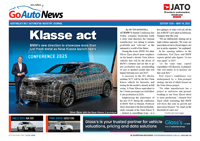Future models - Kia - Optima - TurboFirst drive: Kia confirms turbo for next OptimaOptimum: Kia’s Optima will finally be equipped with the best engine of the lot – a 2.0-litre turbocharged four-cylinder (current Optima pictured left, 2015 fourth-gen version below). No hybrids on the horizon but more turbocharging the way forward for Kia30 Mar 2015 By DANIEL GARDNER in NEVADA KIA is preparing to boost its mainstream model range and brand image in Australia with a greater emphasis on powerful turbocharged engines – and the new-generation Optima is leading the way. The Korean car-maker has confirmed that the all-new Optima – to be officially unveiled at the New York International Auto Show this week, but shown in a full-frontal image ahead of the event – will be launched here with a new turbocharged engine packing a serious punch among mid-size rivals such as the Toyota Camry, Mazda6, Subaru Liberty and Hyundai Sonata. Full details are still under wraps, but GoAuto understands the force-fed 2.0-litre GDI (gasoline direct injection) four-cylinder engine in the current US-only Turbo Optima – good for 204kW of power at 6000rpm and 365Nm of torque from 1650-4500rpm, and paired with a six-speed Sportmatic automatic transmission – is closely matched to the version that will be sold in Australia with the redesigned model due late this year. The performance-oriented engine – which GoAuto sampled, in its current form, during a road trip this week across three US states on our way to New York – will combine with the new Optima’s striking exterior design, more spacious interior, the promise of “class-up” premium features and a host of new safety and infotainment technology. A petrol-electric hybrid powertrain will also be offered on the new Optima in the US, but will not be made available in Australia. In an interview with GoAuto while on the road this week, Kia Motors Australia media and corporate communications manager Kevin Hepworth said the decision to bring the turbo-petrol version but not the hybrid to Australia was largely based on market expectations. And in power-hungry Australia, that means plenty of performance – first and foremost – combined with good economy. “Fuel efficiency is a sales tool in Australia, not a requirement, so while it’s nice, a 1.0-litre engine is not one that will sell well in Australia,” he said. “With the 2.0-litre you get both benefits. “For Australia they are looked at as a performance engine. People don’t tend to look at the fuel-saving capability for an equivalent-sized engine, but your power output from the 2.0-litre is probably the equivalent of a 2.6-litre or 3.0-litre.” He said a hybrid engine, on the other hand, required government incentives in Australia to help the company build a viable business case. “Hybrids don’t sell well in Australia,” he said. “Toyota does theirs, of course, but they had a fair bit of support at the start of the (Camry Hybrid) program. Any other hybrid has the good ‘early adopter’ sales and then they fall right away. “We can’t make a case for hybrid at this stage on a commercial basis.” Our road trip this week started in California and ended in the baron Arizona desert. On test were three variants including the US-market 2.4-litre naturally aspirated version, the petrol-electric hybrid and, importantly, the 2.0-litre turbo. Dressed up in a stunning pearl-white paint job and 19-inch chrome-effect wheels, our test car looked great and stood out brilliantly in the beating Nevada sun. Covering several hundred kilometres of American desert roads is a task not requiring many changes of direction or speed, giving us ample chance to test the car’s ability to eat up miles. At constant speeds of about 120km/h, the Optima is quiet and comfortable, with the well-appointed quilted black leather seats providing good support and the turbo engine remaining muted. The quoted US combined fuel consumption of 9.8 litres per 100km seemed a little unkind compared with our tested figure although we did spend a majority of our time on freeways. With improvements brought with the new model, expect that figure to fall. Acceleration from the 204kW turbocharged engine isn’t earth-shattering, but it is easily the pick of the range and a very good match for Kia’s mid-size sedan. For a majority of driving, the GDI turbo responded well to right-foot commands with decent torque and little lag, but also a satisfying character when revved out to redline. It worked neatly with the six-speed automatic, with the driver able to shift through the gears manually where required via paddle shifters on the (flat-bottomed) steering wheel. Where some turbocharged engines dump peak torque low down the rev range, Kia’s solution slowly feeds in output, broadening the useable band of 365Nm, making progress steady and comfortable whether you are at cruising speeds or stop-start traffic. Compared with the natural-breathing 2.4-litre version, Kia’s 2.0-litre turbocharged engine performs better in all circumstances. In US spec the 2.4-litre atmo uses less fuel than the turbo, and while the jury is still out on Australian figures, expect the force-fed version to come in close to the 2.4-litre. Full details of the new engine will be revealed with the Optima’s unveiling on April 1, but if it behaves anything like the US version we think it will be a valuable addition to the Australian range. We spent the majority of our time focusing on the various drivetrains, but the American test drive also revealed one surprising discovery as a bonus to the trip. Kia puts significant effort into tuning its vehicles’ chassis for Australian conditions and after driving the US-spec Optima on America’s largely good-quality roads, we are all the more appreciative of the car-maker’s local development work. When piloting the hybrid version we found the steering to be numb, communicating little feel from the road with no discernible weight. Manoeuvring was a pleasure but at any speed we felt isolated. America’s roads are generally well maintained and arguably better than Australian blacktop, but the US Optima’s ride quality still suffered over even minor imperfections. Body control was wallowing in corners and the handling discouraged us from pushing particularly hard. Both the base-specification 2.4-litre atmo and the Turbo did a little better with a tighter chassis and more feel through steering, but the drive emphasised just how much work goes into the vehicles sold in Australia. Drive a US hybrid after steering an Australian-tuned Optima and the difference is striking. When it arrives, the 2016 Optima range will bring the excellent local chassis development typical to all Australian-spec Kia models, but also the pick of the engine line-up with a great turbocharged option finally available on home turf.  Read more27th of March 2015  New York show: Kia's Optima fronts upFourth-gen Kia Optima partially revealed with evolutionary styling19th of March 2015  New York show: Kia sketches its new OptimaNext Kia Optima goes all coupe like in sketches revealed ahead of Big Apple showOptima pricing
Motor industry news |
Click to shareKia modelsResearch Kia Optima pricing
Motor industry news |


























Facebook Twitter Instagram